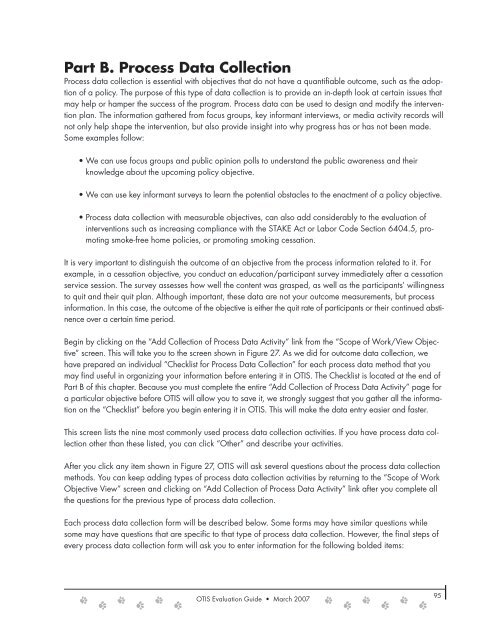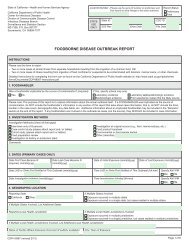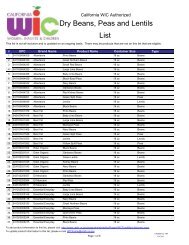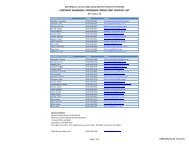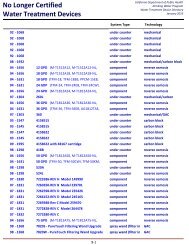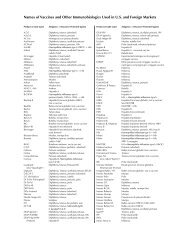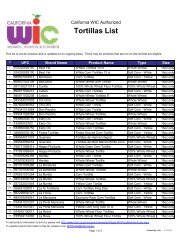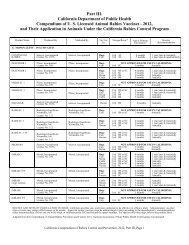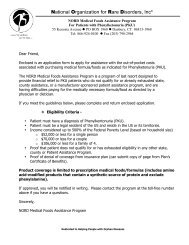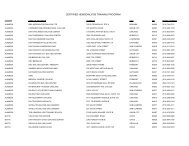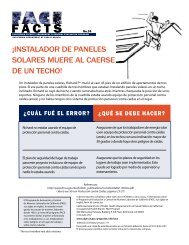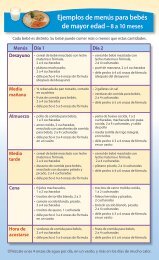OTIS Evaluation Guide (PDF) - California Department of Public Health
OTIS Evaluation Guide (PDF) - California Department of Public Health
OTIS Evaluation Guide (PDF) - California Department of Public Health
Create successful ePaper yourself
Turn your PDF publications into a flip-book with our unique Google optimized e-Paper software.
Part B. Process Data Collection<br />
Process data collection is essential with objectives that do not have a quantifiable outcome, such as the adoption<br />
<strong>of</strong> a policy. The purpose <strong>of</strong> this type <strong>of</strong> data collection is to provide an in-depth look at certain issues that<br />
may help or hamper the success <strong>of</strong> the program. Process data can be used to design and modify the intervention<br />
plan. The information gathered from focus groups, key informant interviews, or media activity records will<br />
not only help shape the intervention, but also provide insight into why progress has or has not been made.<br />
Some examples follow:<br />
• We can use focus groups and public opinion polls to understand the public awareness and their<br />
knowledge about the upcoming policy objective.<br />
• We can use key informant surveys to learn the potential obstacles to the enactment <strong>of</strong> a policy objective.<br />
• Process data collection with measurable objectives, can also add considerably to the evaluation <strong>of</strong><br />
interventions such as increasing compliance with the STAKE Act or Labor Code Section 6404.5, promoting<br />
smoke-free home policies, or promoting smoking cessation.<br />
It is very important to distinguish the outcome <strong>of</strong> an objective from the process information related to it. For<br />
example, in a cessation objective, you conduct an education/participant survey immediately after a cessation<br />
service session. The survey assesses how well the content was grasped, as well as the participants’ willingness<br />
to quit and their quit plan. Although important, these data are not your outcome measurements, but process<br />
information. In this case, the outcome <strong>of</strong> the objective is either the quit rate <strong>of</strong> participants or their continued abstinence<br />
over a certain time period.<br />
Begin by clicking on the “Add Collection <strong>of</strong> Process Data Activity” link from the “Scope <strong>of</strong> Work/View Objective”<br />
screen. This will take you to the screen shown in Figure 27. As we did for outcome data collection, we<br />
have prepared an individual “Checklist for Process Data Collection” for each process data method that you<br />
may find useful in organizing your information before entering it in <strong>OTIS</strong>. The Checklist is located at the end <strong>of</strong><br />
Part B <strong>of</strong> this chapter. Because you must complete the entire “Add Collection <strong>of</strong> Process Data Activity” page for<br />
a particular objective before <strong>OTIS</strong> will allow you to save it, we strongly suggest that you gather all the information<br />
on the “Checklist” before you begin entering it in <strong>OTIS</strong>. This will make the data entry easier and faster.<br />
This screen lists the nine most commonly used process data collection activities. If you have process data collection<br />
other than these listed, you can click “Other” and describe your activities.<br />
After you click any item shown in Figure 27, <strong>OTIS</strong> will ask several questions about the process data collection<br />
methods. You can keep adding types <strong>of</strong> process data collection activities by returning to the “Scope <strong>of</strong> Work<br />
Objective View” screen and clicking on “Add Collection <strong>of</strong> Process Data Activity” link after you complete all<br />
the questions for the previous type <strong>of</strong> process data collection.<br />
Each process data collection form will be described below. Some forms may have similar questions while<br />
some may have questions that are specific to that type <strong>of</strong> process data collection. However, the final steps <strong>of</strong><br />
every process data collection form will ask you to enter information for the following bolded items:<br />
<strong>OTIS</strong> <strong>Evaluation</strong> <strong>Guide</strong> • March 2007<br />
95


